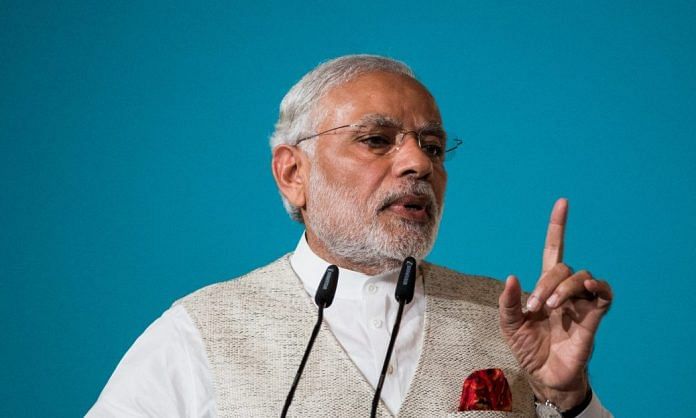Far too many times, journalists experience a sense of déjà vu in their career.
Eight years ago, in April, Anna Hazare had begun his indefinite fast to demand a Jan Lokpal bill. His “Main Anna hoon” campaign began the end of the UPA rule. The charge against the Manmohan Singh government was corruption and the need for a “Congress-mukt Bharat”. In 2019, we have PM Narendra Modi and the BJP’s“Main bhi chowkidar” call. The accused remains the same.
The only major difference is that the Congress was in power at Anna’s time, but now it is a weak opposition. And yet, PM Modi begins and ends every speech by condemning the Congress and the ‘Nehru dynasty’.
Also read: From ‘anti-Modi’ to ‘anti-Congress’, there’s a shift in Lok Sabha poll theme
Nobody can predict what the result of the election would be on 23 May, but the mood in the country is paradoxically anti-Congress and anti-Modi government at the same time. That has made the 2019 Lok Sabha elections most unpredictable.
The mood was similar during the 2014 elections, but there was an element of hope, and frustration with the UPA. Now aspirations have disappeared, only apprehensions remain.
The illusions generated by Narendra Modi’s aggressive campaign had mesmerised the corporate class in 2014. The economic reform-seekers, the urban middle classes, the media, the first-time voters and the entire non-Congress mass of people all welcomed Modi.
Now the corporate class is worried. They talk in hush-hush tones about the concerns they have if Narendra Modi is elected again. While they do want a stable BJP government, they are not happy with PM Modi’s style of governance and feel scared at the rise of party president Amit Shah. At the same time, this class is convinced that Modi is not winning with his own majority. So, it will have to be a coalition led by him or a coalition by someone else in the opposition. That is what scares them.
Although the BJP won 282 seats, it could get only 31 per cent of the vote share (38 per cent for NDA) in 2014. Indira Gandhi won 283 seats in 1967 but had almost 41 per cent of the vote share. In the case of the BJP in 2014, almost 69 per cent of the voters chose to opt out of the frenzy. And yet, the overall mood of the country had been captured by Narendra Modi.
In the last five years, Modi virtually had hegemony over electronic and print media. He was everywhere – addressing NRIs in New York or attending party meetings in Nagpur, or hugging several heads of states. Modi was flying kites in Ahmedabad, sweeping with a broom in New Delhi, and he was even lecturing students before their exams.
Also read: There are very few BJP strongholds or Congress bastions in India. Data shows why
In the mid-1980s, when Doordarshan showed footages of Rajiv Gandhi (there were no private channels), the channel was criticised and condemned as “Rajiv-Darshan”. Now that we look back, Rajiv Gandhi had hardly occupied any audio-visual space.
All the macro level assessments of the 2019 results vary wildly and widely. The BJP is predicted to win anywhere from 150 to 300 seats on its own. The Congress gets anywhere between 75 to 135. The rest of the opposition, divided into various regional-caste-language identities, get the rest. Surely, no other election has flummoxed election experts and the media like this.
Yet, the sense of déjà vu is not because of the unpredictability of the elections, but because of the collective psychological state of the people. There is no common ideological thread, or acceptability of one leader, or an agenda or organisational base. The BJP flaunts its so-called network of RSS karyakartas, but everyone knows that the network loses connectivity in various parts of the country. Even the frenzied Hindutva chest-thumping does not attract voters everywhere.
Also read: The 4 Cs that mark Congress’ decline from secularism to soft Hindutva
The spectre of anarchy and chaos looms not only because of the divided opposition, but also because of the anxiety and nervousness felt by people who fear a comeback of the Modi-Shah-Doval troika.
We have entered a political vacuum, and like Alice in Wonderland, do not know the direction or the pace at which we are falling, or the nature of the free fall.
Kumar Ketkar is a former editor and Congress member of Rajya Sabha.




Oh, pity that this “sell out” is so “flummoxed”! Seemed like it was only yesterday that he was so pleased with himself (and his Rajya Sabha seat, as a gift from the Congress) and the chances of the Congress party and its assorted corrupt cronies coming to power!
Koi vacuum nahin hai. True, no one will get a majority. However, seeing what has been delivered over the last five years, that is not necessarily a bad thing. Assembling a stable majority will involve tough bargaining; the regional leaders are seasoned practitioners of realpolitik. Many would talk to both sides. In 2014, the media helped create the buzz. This time round, it is creating fog that prevents what is otherwise a very tough election for the incumbent from being widely seen as such.